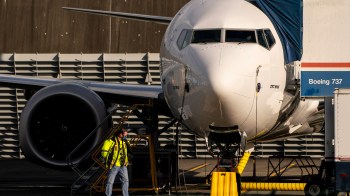The science of airplane interior design
TEXT OF INTERVIEW
Kai Ryssdal: I can report back from the front lines of the aviation industry that as many people as ever seem to be traveling this holiday weekend. Three lovely hours in the Denver airport last night gave evidence of that. Airlines, though, are still looking for ways to save or make a buck. They’re charging for checked bags, they’re cutting out food, even the peanuts, and they’re cramming as many people as they can into their planes. Finding new and creative ways to get more seats on a plane that’s not going to get any bigger involves some sleight of hand. Making fliers think we have more leg room than we really do. Paul Wylde designs airplane interiors for a living.
Paul Wylde: One can argue that design is always compromised. I mean, a good designer is juggling the needs of the end-user, understanding the manufacturing process as available at the time, the limitations of technology, cost, of course, and also a designer tries to get their own artistic intent within the project. And, of course, designing for aviation is extreme design. You’re seven-and-a-half miles in the air, and you’re traveling at half the speed of sound. And that brings with it unique opportunities, but then unique limitations as well.
Ryssdal: It’s also a compromise by the fact that the economics of the industry dictate one of the key components of that design, which is as many bodies on the plane as possible.
WYLDE: Absolutely. It’s always a compromise, and designers always grapple with what’s worth paying more for. A designer would dream of a larger wash room, a larger seat, but is that a benefit that an end user would pay more for. We’re seeing a polarization of the travel experience, so we’re seeing the first-class products becoming even more elaborate. And we’re seeing, unfortunately, a lot of the economy cabins suffering through cost-cutting.
Ryssdal: So how do you design a new airplane, the interior, to get more space for those seats?
WYLDE: There’s lots of ammunition that a designer can potentially use to give the illusion of greater space. We try to keep the plane interior as simple as possible, and we refer to this as the form language. So spaces which have more curves, floating elements, so parts of the aircraft interior that don’t actually meet each other, they appear to float in space, and trying to increase the sensation of perspective within the cabin. These are all tricks that designers try to use. And there’s clever things we do with lighting. We can illuminate the cabin ceiling in interesting ways. We can play with color and intensity of lighting. And we can also add some clever tricks such as mirror surfacing to give the illusion of greater space.
Ryssdal: There is, though, a finite limit. No matter how clever a designer you are, you can’t get more bodies on a 737 than you can get on, right?
WYLDE: Sure, absolutely. We’ve really kinda have hit a brick wall now. So it’s about trying to create the illusion of space, and it’s about trying to provide more comfort on a micro-scale. But ultimately, we’ve got a restricted space, and it’s up to us now to try to reclaim space in an interesting and engaging way.
Ryssdal: Would you be disappointed if I told you, and I’m going to just guess that I’m speaking for the flying public here, that when we got on an airplane we’re not looking at those floating design elements, and lighting stuff. We’re keeping our heads down, cramming our bags in the overhead bin, and hoping we don’t get a middle seat.
WYLDE: Well, I’ve debated this for years. I don’t think people do identify all of the hard work that has gone into creating an aircraft interior, but a passenger will reflect upon a good experience, or a bad experience. There’s no doubt. They won’t deconstruct the elements, but they’ll appreciate that overall they’ve had a better experience.
Ryssdal: Paul Wylde, at Teague Aviation Design, up in Seattle, Wash. Paul, thanks a lot.
WYLDE: It’s a pleasure. Thank you.
There’s a lot happening in the world. Through it all, Marketplace is here for you.
You rely on Marketplace to break down the world’s events and tell you how it affects you in a fact-based, approachable way. We rely on your financial support to keep making that possible.
Your donation today powers the independent journalism that you rely on. For just $5/month, you can help sustain Marketplace so we can keep reporting on the things that matter to you.


















